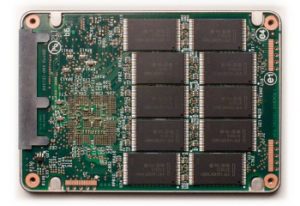
The inside of an SSD with NAND chips.
The TRIM command is an operation that enables solid-state drives (SSD) to efficiently manage garbage collection. In another article, we explain in detail how the TRIM command improves performance reliability for SSDs.
SSDs generally support the TRIM command. Some hard drives also use the operation — specifically, shingled magnetic recording (SMR) hard drives, which have a higher areal density than typical consumer hard drives.
But while the TRIM command can extend the life of your storage media, there’s a downside: In some situations, TRIM can prevent traditional data recovery methods from restoring lost data.
TRIM overwrites data, which results in permanent data loss.
The purpose of the TRIM command is to tell the computer’s operating system about pages that no longer contain valid data. This is only applicable to SMR hard drives and SSDs — conventional hard drives store data in a fundamentally different way, and the TRIM command is unnecessary.
When the TRIM command executes, the operating system will clear out the affected pages. If you opened those pages with a hex editor (software that allows the user to manipulate binary data), you’d see all 0s — the data would be irretrievably destroyed.
In other words, if you delete a file from a storage device with TRIM enabled, your data will be lost the moment that the TRIM command executes. This happens fairly quickly, and the command may execute during start-up processes.
If you’ve just deleted a file, you could immediately disconnect the power source for your computer, but you’d need the resources of a professional data recovery laboratory to have any chance at a successful recovery.
I’ve deleted a file from an SSD. Is data recovery possible?
On SSDs and SMR hard drives, deleted files are often unrecoverable, provided that you’ve actually deleted the file (in other words, you didn’t just move it to the recycle bin).
But in some cases, recovery may be possible, depending on how the device’s TRIM process is handled. Datarecovery.com provides free evaluations, and we support our services with a no data, no charge guarantee: If data recovery is unsuccessful, you don’t pay for the attempt.
If you’ve deleted a file — or if you can’t read a file due to corruption, a physical storage issue, or for any other reason — follow these steps:
- Immediately disconnect power to the storage device.
- Do not attempt to use data recovery software. Read why using software can lower the chances of a successful recovery.
- Contact a professional data recovery provider. Follow the provider’s instructions for packaging and shipping your device.
- Describe the exact events and circumstances that led to data loss. For example, if you accidentally deleted a file, the data recovery strategy will be very different from the strategy for treating file corruption.
Datarecovery.com’s services are designed to support consumers and businesses while providing peace of mind throughout the recovery process. To get started, schedule a free evaluation online or call 1-800-237-4200 to speak with an expert.




